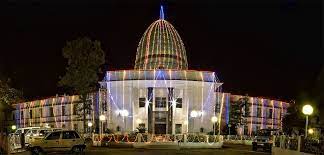High Court dismissed the appeal filed by the convict-accused and thereby affirmed the judgment and order of conviction and sentence of death passed by the Additional Sessions Judge Court No. 6, Bijnore for the offence punishable under Sections 302, 436 and 326-A of the Indian Penal Code, 1860 (for short, ‘the IPC’) respectively. (Para 1)
On 06.08.2014, at around 12.30 am, the PW-2 is said to have woken up to see flames and smoke coming from the room, where the deceased persons were sleeping. The PW-2 and his sister Soni (PW-4) claim to have seen the appellant-convict setting the room on fire and thereafter, fastening the door latch from outside and running away. (Para 10)
If PW-2 and PW-4 were present at the time when the room was on fire and it is they who opened the door and took out the three deceased persons, then why the PW-2 and PW-4 do not figure in the dying declarations of Irshad and Islamuddin? Why Islamuddin and Irshad said in their dying declarations that after a long time, the neighbour came to their rescue and took them out of the room? If a neighbour came to their rescue, then where were PW-2 and PW-4 at the time of the incident? PW-2 and PW-4 have deposed that they both were sleeping in the room adjacent to the room in which the deceased persons were sleeping. This is one very crucial aspect of the matter which, the prosecution has not been able to explain or clarify. (Para 41)
We should also look into the genesis of the occurrence from a different angle. It is not in dispute that the three deceased died on account of severe burn injuries. It is also not in dispute that the room in which they were sleeping caught fire on account of which they suffered severe burn injuries. It is also not in dispute that inflammable substance like kerosene was found from the room which ignited the fire. However, the moot question is who set the room on fire? Could it be said that the prosecution has been able to prove beyond reasonable doubt that it was only and only the appellant-convict who set the room on fire by pouring the inflammable substance? (Para 45)
We find it very difficult to believe that the appellant-convict was still inside the room or even outside the room to be witnessed by the deceased persons as well as by the PW-2 and PW-4, locking the room from outside after setting the room on fire. The conduct of the accused may be unnatural because he was residing in the very same house, however, the conduct which may be a relevant fact under Section 8 of the Indian Evidence Act, 1872 (for short, ‘the Act 1872’), by itself may not be sufficient to hold a person guilty of the offence of murder. (Para 46)
On overall assessment of the materials on record, we have reached to the conclusion that neither the two dying declarations inspire any confidence nor the oral evidence of the PW-2 and PW-4 respectively inspire any confidence. Had the dying declarations stood corroborated by the oral evidence of the PW-2 and PW-4, then probably, it would have been altogether a different scenario. However, as noted above, the two dying declarations are not consistent or rather contradictory to the oral evidence on record. (Para 47)
The justification for the sanctity/presumption attached to a dying declaration, is two fold; (i) ethically and religiously it is presumed that a person while at the brink of death will not lie, whereas (ii) from a public policy perspective it is to tackle a situation where the only witness to the crime is not available. (Para 48)
The Courts are first required to satisfy themselves that the dying declaration in question is reliable and truthful before placing any reliance upon it. Thus, dying declaration while carrying a presumption of being true must be wholly reliable and inspire confidence. Where there is any suspicion over the veracity of the same or the evidence on record shows that the dying declaration is not true it will only be considered as a piece of evidence but cannot be the basis for conviction alone. (Para 61)
It is the duty of the prosecution to establish the charge against the accused beyond the reasonable doubt. The benefit of doubt must always go in favour of the accused. It is true that dying declaration is a substantive piece of evidence to be relied on provided it is proved that the same was voluntary and truthful and the victim was in a fit state of mind. It is just not enough for the court to say that the dying declaration is reliable as the accused is named in the dying declaration as the assailant. (Para 63)
It is unsafe to record the conviction on the basis of a dying declaration alone in the cases where suspicion, like the case on hand is raised, as regards the correctness of the dying declaration. In such cases, the Court may have to look for some corroborative evidence by treating the dying declaration only as a piece of evidence. The evidence and material available on record must be properly weighed in each case to arrive at an appropriate conclusion. The reason why we say so is that in the case on hand, although the appellant-convict has been named in the two dying declarations as a person who set the room on fire yet the surrounding circumstances render such statement of the declarants very doubtful. (Para 64)
In the present case, it is difficult to rest the conviction solely based on the two dying declarations. At the cost of repetition, the PW-2 has been otherwise also not believed by the High Court.
SUPREME COURT OF INDIA
2023 STPL(Web) 207 SC
[2023 INSC 758]
Irfan @ Naka Vs. State Of Uttar Pradesh
Criminal Appeal Nos. 825-826 of 2022-Decided on 23-8-2023
https://stpllaw.in/wp-content/uploads/2023/08/2023-STPLWeb-207-SC.pdf







